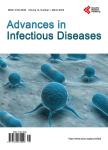Genetic Diversity of Uropathogenic Escherichia coli Isolated from Human T Lymphotropic Virus Type I (HTLV-I) Infected Individuals
Genetic Diversity of Uropathogenic Escherichia coli Isolated from Human T Lymphotropic Virus Type I (HTLV-I) Infected Individuals作者机构:Escola Nacional de Saúde Pública Sergio Arouca Fundaç ã o Oswaldo Cruz Rio de Janeiro Brazil Instituto Nacional de Infectologia Fundaç ã o Oswaldo Cruz Rio de Janeiro Brazil Instituto Nacional de Controle de Qualidade em Saúde Fundaç ã o Oswaldo Cruz Rio de Janeiro Brazil
出 版 物:《Advances in Infectious Diseases》 (传染病进展(英文))
年 卷 期:2016年第6卷第4期
页 面:163-173页
学科分类:1007[医学-药学(可授医学、理学学位)] 100705[医学-微生物与生化药学] 1001[医学-基础医学(可授医学、理学学位)] 100103[医学-病原生物学] 10[医学]
主 题:Uropathogenic Escherichia coli Genetic Diversity Phylotype HTLV-I+
摘 要:Urinary tract infection (UTI) is a frequent pathology among HTLV-I+ individuals being capable of severely compromising the kidneys and bladder. Molecular characteristics of uropathogenic Escherichia coli (UPEC) from HTLV-I+ infected individuals are unknown. UPEC isolates from HTVL-I+ individuals, with and without clinical symptoms of myelopathy, were submitted to genetic typing seeking to infer bacterial diversity and potential virulence. 71 bacterial isolates were characterized according to random amplified polymorphic DNA and phylotypes. Phylotyping classified E. coli into four phylogenetic groups: A (18.3%), B1 (16.9%), B2 (39.4%), and D (25.3%) and 8 phylotypes according to the presence of the genetic sequences chuA, yjaA and the DNA fragment TSPE4.C2: ﹣﹣﹣ (5.6%) and ﹣+﹣ (12.6%) in phylogroup A, ﹣﹣+ (7.0%) and ﹣++ (9.8%) in B1, +++ (32.3%) and ++﹣ (7.0%) in B2, +﹣﹣ (15.4%) and +﹣+ (9.8%) in D. The B2 phylogroup was the most prevalent among HTLV﹣ associated myelopathy and asymptomatic individuals. RAPD-PCR typing revealed a high degree of bacterial polymorphism indicating a non-clonal origin. Genotypes were not found to be distributed according to clinical status or epidemiological features. Our results lead us to suggest that the neurological impairment in HTLV-I+ individuals can be a risk factor for urinary infections due E. coli which are caused by distinct bacterial lineages.



